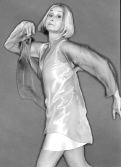TWYLA THARP DANCE
Paramount Theatre, 911 Pine 292-ARTS, $22-$55 8 p.m. Fri., Nov. 2 and Sat., Nov. 3
LINES CONTEMPORARY BALLET
University of Washington, Meany Theater, 543-4880, $38 8 p.m. Thurs., Nov. 1-Sat., Nov. 3
CHOREOGRAPHER George Balanchine used to compare his job to a chef’s—both involve combining a number of ingredients to make something new. And if there’s an undisputed master of fusion cooking in the modern dance world, it’s Twyla Tharp.
Tharp has drawn inspiration and material from every direction for over 30 years. Her dances sweep you along with their kinetic appeal, while you madly try to keep track of their multilayered patterns and internal references. Her 1973 commission from the Joffrey Ballet, Deuce Coupe, brought her national recognition as arguably the first and best “crossover choreographer,” someone who combines vocabulary and conventions from many different dance forms.
Since that time, her work has played on standard concert stages with her own company, in ice rinks with choreography for skater John Curry, and in films like Milos Foreman’s Hair and Amadeus. As she combines popular and “high” culture, referencing contemporary comic strips and 19th-century performance practice at the same moment, she confounds traditional definitions of dance style and genre. Tharp has made a body of work that can engage the newest dancegoer while challenging the most experienced viewer.
When Tharp dissolved her first company around 1986 and became an artistic associate of American Ballet Theater, her crossover credentials were solidified, placing her eclectic works on programs alongside staples of the ballet repertory. Even so, her audience has been particularly happy to see her re-establish her own ensemble, Twyla Tharp Dance, with a group of performers handpicked to fulfill the particularly juicy and tricky aspects of her choreography. The program she’s bringing to Seattle includes 1983’s Sinatra Suite, a series of duets based in ballroom dance originally made for Mikhail Baryshnikov, and will also include a handful of new works set to music that ranges from Seattle native Mark O’Connor’s fiddle-influenced score for Westerly Round and Donald Knaack’s junk percussion compositions in Surfer at the River Styx (Tharp’s “loose exploration” of Euripides’ “Bacchae”).
AS THARP has continued to open new doors for herself, she’s expanded possibilities for other choreographers as well. Oakland-based Alonzo King has been pushing the edges of contemporary ballet for several years in works for his company, Lines, that build on the flexibility and strength of ballet training. His newest work, The People of the Forest is probably the biggest challenge he’s taken on. King has augmented his regular company with a group of 16 BaAka dancers and musicians from the Central African Republic. Sometimes known as pygmies, the BaAka come from a culture in which music and dance are an integral part of everyday life, and mixing their contribution with the more theatrical conventions of ballet is just one of the tricks that King has to pull off with this piece.
Even more crucial than issues of context, though, is the intrinsic difference in the two movement styles. At its heart, ballet is often about escaping gravity—the ability to rise and to reach, to go beyond the usual limits imposed by our bodies. The BaAka dance down into the earth, dropping their weight into the ground and using the elasticity of their sinews to create an ongoing pulse that is also expressed in their music. In this particular example of “fusion cooking,” it might be that the combination of ingredients will serve to show us how distinct they really are.








